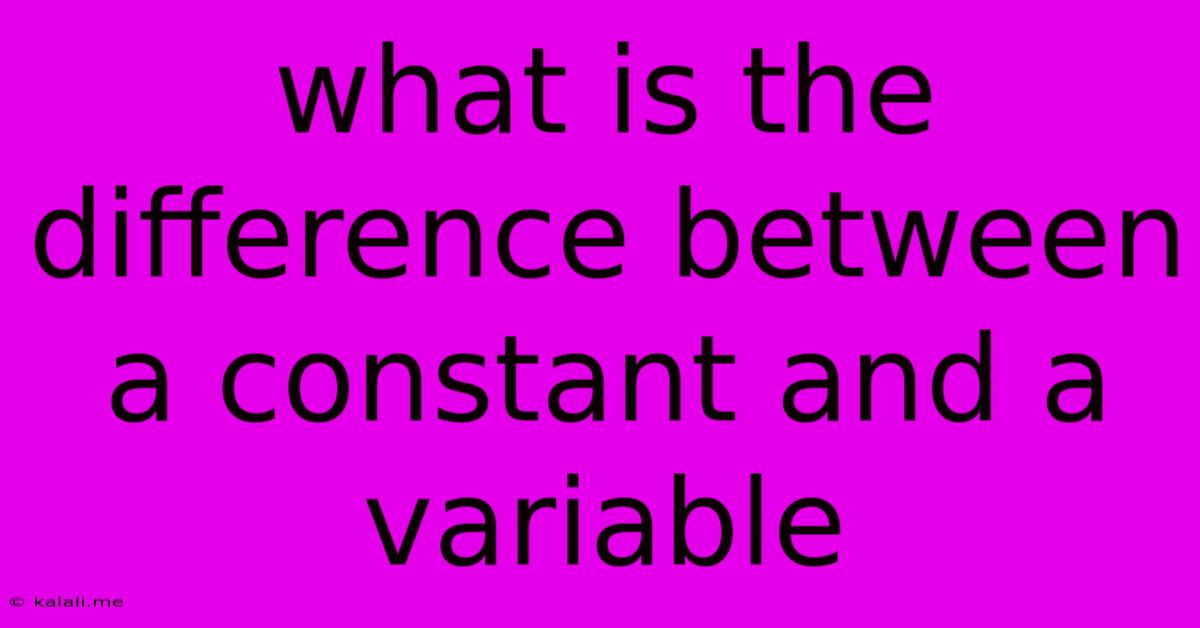What Is The Difference Between A Constant And A Variable
Kalali
May 22, 2025 · 3 min read

Table of Contents
What's the Difference Between a Constant and a Variable? A Programmer's Guide
Understanding the difference between constants and variables is fundamental to programming. While both store data, their key distinction lies in mutability – the ability to change their value during program execution. This article will explore this core concept, providing clear examples and highlighting the importance of choosing the right one for your coding needs. It will cover the concept in various programming languages, explaining how they're declared and used.
In essence, a variable's value can change, while a constant's value remains fixed throughout the program's lifespan. This seemingly simple difference has significant implications for code readability, maintainability, and even performance in some cases.
Variables: The Changeable Data Holders
Variables are named storage locations in a computer's memory that hold values which can be modified during program execution. Think of them as containers that can hold different data types, such as numbers, text (strings), or boolean values (true/false). Their value can be assigned, re-assigned, and updated as needed within the program's logic.
Example (Python):
name = "Alice" # Assigning a value
name = "Bob" # Re-assigning a different value
age = 30
age += 1 # Modifying the existing value
In this Python example, name and age are variables. Their values can be changed multiple times throughout the program's execution.
Constants: The Immutable Guardians
Constants, on the other hand, are named storage locations that hold values which cannot be changed after they're initialized. Once a constant is assigned a value, that value remains fixed for the duration of the program's run. They are used to represent values that should not be altered, improving code reliability and preventing accidental modifications.
Example (C++):
const double PI = 3.14159; // Declaring a constant
// PI = 3.14; // This would result in a compiler error
In C++, the const keyword signifies that PI is a constant. Any attempt to change its value after initialization would result in a compiler error. The same concept applies to other languages, often using similar keywords or conventions.
Key Differences Summarized:
| Feature | Variable | Constant |
|---|---|---|
| Mutability | Mutable (changeable) | Immutable (unchangeable) |
| Value Changes | Can be changed during program execution | Cannot be changed after initialization |
| Use Cases | Storing data that needs modification | Storing fixed values, configuration data |
| Naming | Often lowercase with descriptive names | Often uppercase or with specific prefixes |
Importance and Best Practices
Using constants effectively improves code readability and maintainability. By clearly indicating values that shouldn't be altered, you reduce the risk of introducing bugs and make your code easier to understand and modify. For instance, using constants for physical constants (like PI or the speed of light), magic numbers (unexplained numerical values), or configuration parameters is a good practice.
Choosing between a variable and a constant depends entirely on the context and intended use of the data. If the value might need to change, use a variable. If the value should remain fixed, a constant is the better choice. Consistent and thoughtful use of constants significantly contributes to cleaner and more robust code.
Latest Posts
Latest Posts
-
How Much Is 25 20 Dollar Bills
Jul 05, 2025
-
How Many Apples In 3 Lb Bag
Jul 05, 2025
-
What Is Half A Quarter Of 400
Jul 05, 2025
-
How Do You Make A Vegetable Necklace
Jul 05, 2025
-
How Many 750ml Are In 1 75 Liters
Jul 05, 2025
Related Post
Thank you for visiting our website which covers about What Is The Difference Between A Constant And A Variable . We hope the information provided has been useful to you. Feel free to contact us if you have any questions or need further assistance. See you next time and don't miss to bookmark.